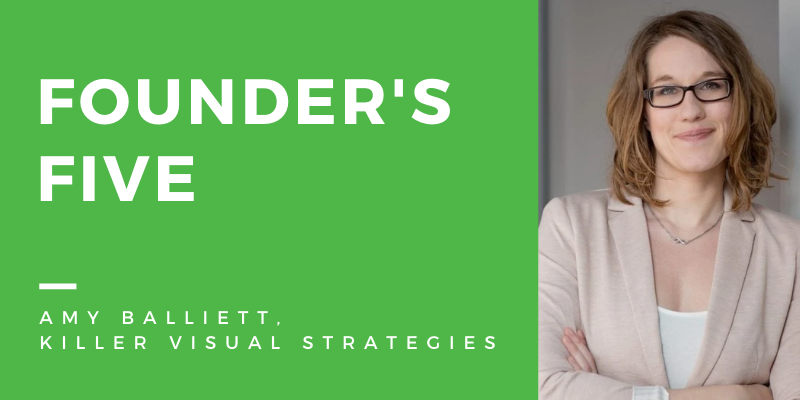With all the craziness and bad news 2020 has served up, it’s inspiring to learn about the innovation and goodness so many of our members and member companies are creating.
One of our long-time friends and New Tech presenter alumni, Amy Balliett, has been inspiring as a 40 Under 40 alumni, entrepreneur since the age of 17, speaker at over 175 international conferences, founder who has sold her company, and now she’s an author sharing her expertise that’s helped startups to Fortune 1,000 companies.
We’re excited to share some of her wisdom with you in an AMA virtual event on Tuesday and in our newsletter today.
Since 2013 we’ve been reaching out to founders around the PNW to ask them 5 questions to gain insights and inspiration. This week we talked with Amy about the the importance of building a company defined by it’s values and how her experience and love for visual media led her into writing her new book, Killer Visual Strategies.
1. Why do you do what you do for a living?
I am the CEO and founder of the leading visual communication agency, Killer Visual Strategies (formerly Killer Infographics). I am a public speaker, SVC teacher, and LinkedIn Learning instructor on the topic of visual communication and creative content marketing. I am also an author, with my first book (also named Killer Visual Strategies) having just recently been released on June 30th.
2. Why did you start your company?
This is quite a long story so I’ll give you the cliff notes version. Like most millennials, I’ve jumped in and out of many different career fields, but they all culminated with Killer Visual Strategies.
I went to film school because of my love for animation and live action media. I minored in marketing because that was another passion of mine.
Once I graduated, I moved to Seattle and got a job in feature film market research. I followed that up with a job as a video editor and designer (which is how I learned design) before I completely pivoted to SEO and online marketing.
Killer is really the culmination of all of these past experiences because visual storytelling and visual communication combine my passions for marketing and rich media. For the full story, check out my book and the introductory section titled “An Accidental Agency.”
3. What is one of the greatest lessons you’ve learned from being a founder?
Everything comes down to culture and values. When you build a company that is defined by its values, then hire a team that embraces those values, and partner with clients that also respect those values, something almost magical happens. Alignment on values makes it easy to solve any problem, because you can look at issues with those values as a lens, in a sense. Hiring and firing both clients and employees based on how they live your values shows a strong commitment to these “rules of engagement” as well. When the entire team and company lives and leads by a core set of values, there is no challenge too hard to overcome because your company culture becomes extremely strong. People love to work on a team with a great culture. People put the team first because they know that their coworkers will do the same. Everyone feels united in the mission and vision of the company and everyone feels excited to achieve the growth goals in front of them. By building a values-based company, I’ve found that I’m elated everyday to be working with the world class team at Killer. We have become a one of a kind team, a family, and a foundation of support for one another and that makes every part of the business an amazing experience.
4. What is the one piece of advice you would share today with your younger self before she started your company?
Make hard decisions based on both the company’s values and the best logical outcome for the business, then take swift action. This less is hard to learn, but one that I think is imperative to success. It’s human nature to see the best in people and hope that situations will fix themselves, but avoiding conflict only leads to a problem festering and hurting the culture of the company. I had to learn this the hard way a few times. In fact, it took until 2015 for me to truly embrace the values-based company approach already noted. Once we started hiring and firing by our values, we saw immediate improvements across the board. I’ve had to learn to put the needs of the company above my own personal feelings, but using our values as a framework has made this easier. I’ve also learned that the faster I act on a tough decision, the faster the team recovers. So, while I still have to remind myself of this advice from time to time, it’s become more natural for me to act quickly on tough decisions and let those decisions be guided by our values and the needs of the business rather than emotions.
5. What is something about you that people would be surprised to learn?
I’m actually finding that a log of people are surprised to learn that I wrote a book. I mean heck, I’ve spent 10 years evangelizing the art of visual communication which is inherently a very low-text medium, so why is it that I just wrote 45,000 words about it and turned it into a book?? What might be even more surprising is the fact that I loved every single minute of writing the book and am chomping at the bit to write another! But the reason I wrote the book is because the rise of visual communication doesn’t mean that the written word is dead. It simply means that it takes more than a catchy headline these days to capture the attention and loyalty of your audience. Those who have watched my LinkedIN Learning courses or have seen me speak have continued to ask for as much information as I’m able to share on the topic, so it made sense to capture it all in one place. I chose a book because I wanted something tactile that would act as a go-to resource for anyone looking to excel in the world of visual content. I wrote it to be a guide that anyone can read end-to-end, simply jump to any page and gain relevant insight, or test their skills with the myriad exercises outlined in the book. To me, it’s ironic to teach about visual communication in such a text-heavy medium, but since so many wanted to hear directly from me I felt that this was one of the best sources to provide exactly my thoughts on the subject, word-for-word.












